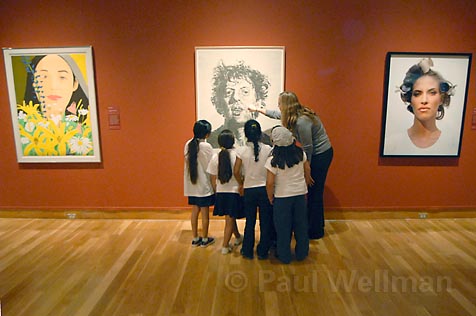Collaborative Art Program Draws Out the Best in Youth
Forging Identities

The art lesson that Itoko Maeno is presenting to a group of fifth- and sixth-graders has something in it for everyone, and it’s also highly challenging. It simultaneously teaches artistic concepts (such as warm versus cool colors) and requires the mastering of multiple skills (including painting, printmaking, stenciling, collage, and even brainstorming.) It involves not only images but also words and symbols, and demands introspection and self-expression. At one point, Maeno says to the ten students assembled, “Just keep your mind open and keep writing : put down any words that come to mind.” The project is a meditation on place and identity, but it also builds on a number of classes the students have already participated in, and asks them to follow a series of complicated instructions, in order. Welcome to the Santa Barbara Police Activities League (PAL) art outreach program, a program made possible by PAL’s partnership with the Santa Barbara Museum of Art (SBMA).
Similar classes are offered Monday through Friday from 3-4 p.m. at the Ridley-Tree Education Center, with different school groups attending each day of the week. In addition to the guidance of their teacher, the students benefit from the help of two teenaged mentors from Santa Barbara High School’s Visual Arts and Design Academy. During a recent meeting, the class took a trip to SBMA to view the new exhibition, “Identities,” which has served as an inspiration for their current project. But none of these young people is a stranger to the museum. In fact, they’ve all had their own work exhibited there, thanks to this program.
PAL is the major funder for the 10-week program, designed with an aim to curb youth violence by inspiring participants with a sense of belonging and accomplishment. PAL pays for the majority of the supplies and the teachers’ salaries, recruits the students, and provides transportation to the classes and the family days. SBMA supplements PAL’s funding by offering the services of its expert, museum-trained teachers; creating the curriculum for the program; and providing access to the classroom and the museum. SBMA has also done much to involve the families of the students; for example, staff invited them to a recent family day for D-a de los Muertos, for which there was a large turnout.
This trimester alone, 50 students-all of them participants in the A-OK after-school program at Title One schools-are participating in the in-depth program, an opportunity they might otherwise never have had. Two more 10-week sessions will follow this one, involving approximately 100 more upper-grade elementary school students and running until the end of the academic year. Patsy Hicks, SBMA assistant director of education, describes the program as building “not only skills in the arts, but also confidence in terms of students’ own personal lives. It gives them a connection in the community that they might not have known they could have. This place becomes not just some large building that they might never enter on their own, but an extension of their classroom, an extension of their family room. This is just the beginning of a lifelong involvement.”
Some may think of PAL as running after-school activities involving sports like boxing and soccer. PAL did once stand for Police Athletic League, after all. But the police department’s collaboration with SBMA shows just how much the PAL program has expanded in Santa Barbara. As Bryan Kerr, PAL coordinator for the project, explains, “PALs vary by community. We try to go in and fill in wherever there is a gap. Our programming is based on funding and support.” Kerr is enthusiastic about the wide range of support he has found in Santa Barbara, and particularly for this partnership. Indeed, the impetus for the collaborative program, currently in its first year, came from the museum itself in response to the increased youth violence that occurred during the 2006-2007 school year. As Hicks explained, “Many community organizations felt the same way; they wanted to help. We might have always known that this was a need, but it was brought very visibly to our attention through what was happening.” The program is offered to younger students with the hope that, as Kerr puts it, “if we get them exposed to PAL now, when they hit junior high, they’ll already know what we’re about and will be willing to be involved.”
But it is clear from talking to the students that they are already more than willing. When asked why they had wanted to take part in the program, all ten insisted that it was because they “love art a lot,” though it wasn’t clear whether they had always felt that way, or whether they had been converted in the last few weeks. The most commonly used adjective to describe the program? “Fun.”
4•1•1
Beginning in December, the students’ artwork will be on display at the Ridley-Tree Education Center, 1600 Santa Barbara Street. Their work will also be on view at a free family event at SBMA on February 10, 2008, to celebrate Chinese New Year. For more information on the SBMA/PAL arts outreach program, call 884-6432.



